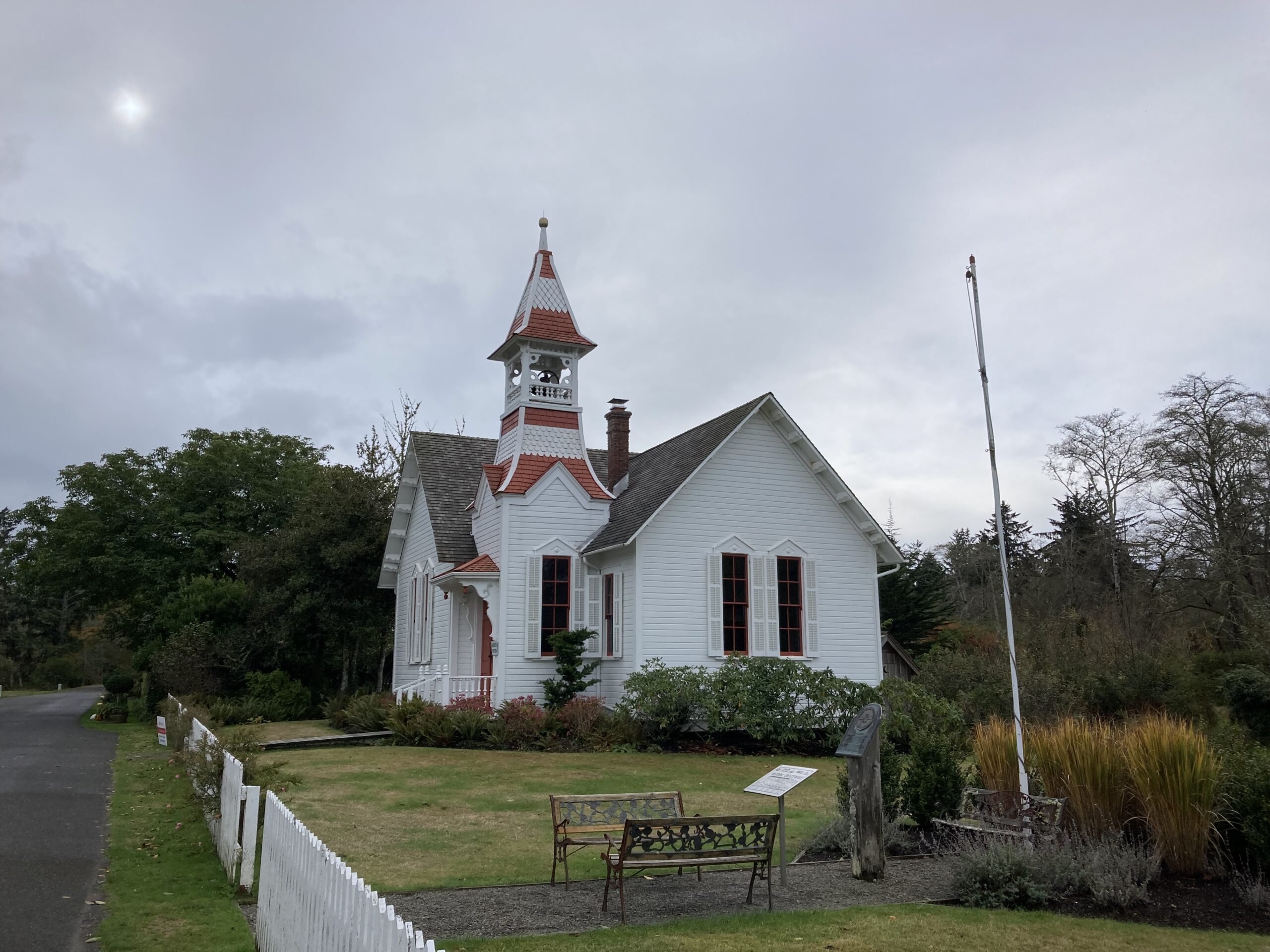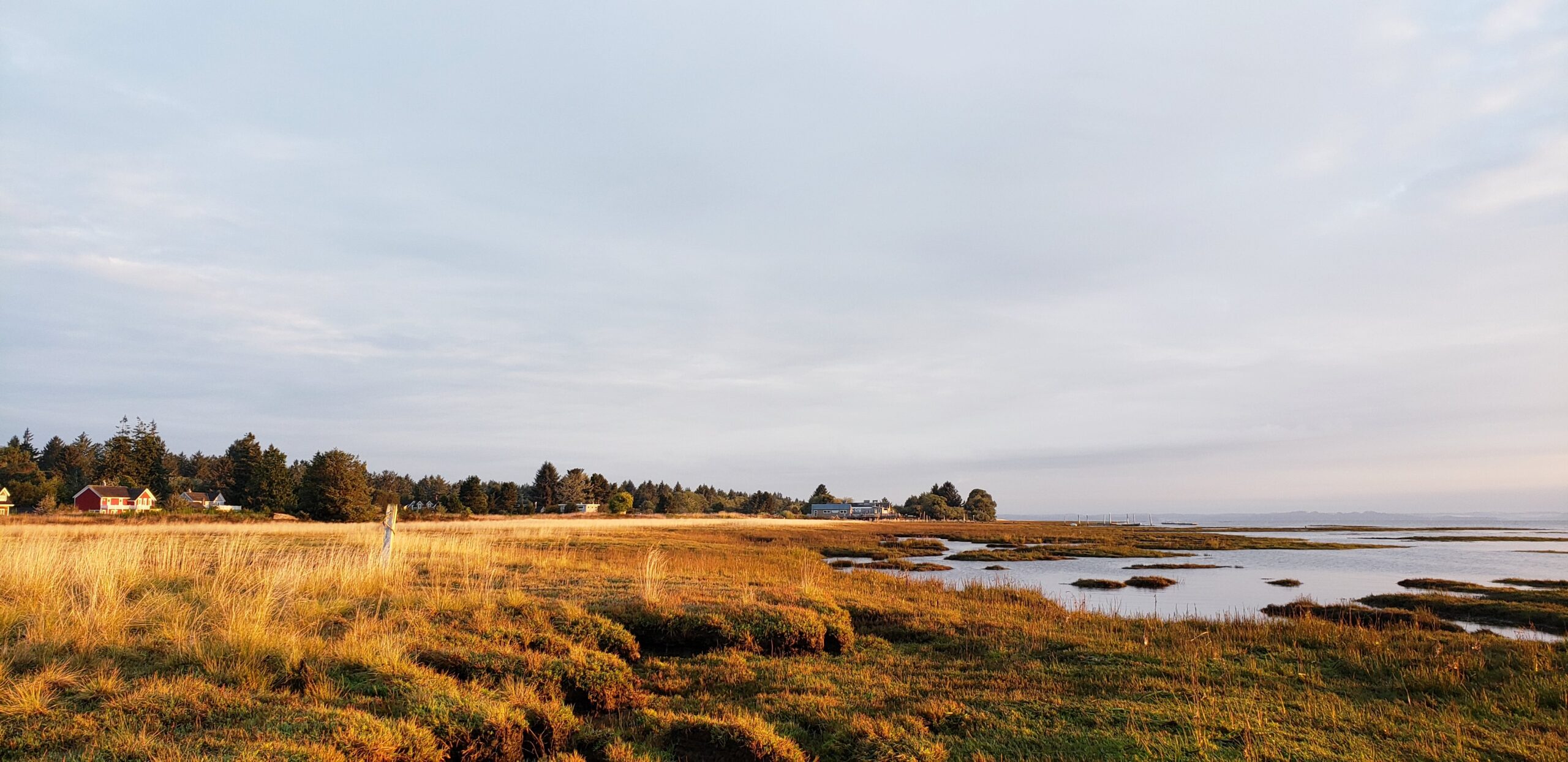Select a topic below to learn about Oysterville.
National Historic District
National Historic Districts are identified and recognized to provide an insight into the past and to preserve the relationship of the surviving structures and cultural features within their setting. The U.S. Federal government designates historic districts through the U.S. Department of the Interior and under the auspices of the National Park Service.
The town of Oysterville was founded along the banks of Willapa (once called Shoalwater) Bay in 1854, by I.A. Clark and R.H. Espy. They were guided to the oyster beds by an Indian named Nahcotta and they promptly began harvesting the shellfish. Oysterville’s development was directly related to the harvesting of native oysters and shipping them to San Francisco in the 1850s – 1880s. Oysterville is located on the sheltered side of the Long Beach Peninsula and it was once the Pacific County seat. Within the village are several surviving residences and other buildings constructed in the late 1860s and early 1870s, some of which are significant for their architectural qualities. These are among the few remaining structures associated with one of the northwest’s earliest industries.
In addition to being a National Historic District, Oysterville is also a designated Pacific County Historic District. Both designations give recognition to the historical significance of the village and offer some protection against careless development and the ravages of time.
Choosing to own property in the district is choosing to participate in the preservation of Oysterville. Mandatory guidelines exist for new development as well as restoration and renovation of existing structures within the district. A hearings examiner was appointed by Pacific County to review and approve all development proposals. Contact the Pacific County Department of Community Development for a copy of the Oysterville Design Guidelines.
National Register of Historic Places
On May 12, 1976, Oysterville received notification from the Washington State Advisory Council on Historic Preservation that the Oysterville Historic District had been selected by the Keeper of the National Register for placement in the National Register of Historic Places.
Oysterville’s History
The Story of Oysterville
For generations before the pioneer settlers arrived, Chinook Indians gathered oysters in this part of Willapa Bay and camped in the area that is now Oysterville. They called it “tsako-te-hahsh-eetl” which, like many Indian words, had two meanings: “place of the red-topped grass” and “home of the yellowhammer.” (Yellowhammer is the local name for the red-shafted flicker, a woodpecker common to this region.)
The first white settlers here were Robert Hamilton Espy and Isaac Alonzo Clark. They had agreed on a rendezvous with Chief Klickeas who had told Espy of nearby tide lands covered with oysters. On April 20, 1854, as they paddled north from the head of the bay, they became engulfed by a heavy fog. Klickeas, having spotted them before the fog rolled in, guided them ashore by rhythmically pounding on a hollow log. The Indian Chief had not exaggerated; reef upon reef of tiny native oysters grew on the shallow bay bottom. Espy and Clark marketed the bivalves in gold-rich, oyster-hungry San Francisco. A peach basket filled with oysters brought a dollar in gold on delivery to a schooner anchored on the tide flats in front of town. That same basket brought $10 on arrival in San Francisco, and epicures in oyster bars and seafood restaurants there would pay a silver dollar for one oyster – an oyster smaller than the dollar!
In no time, Oysterville became a rowdy, lusty boomtown. By 1855 its population and importance were such that it became the seat of Pacific County, Washington Territory. The town had many firsts – a school, college, newspaper, and finally, in 1872, a church – First Methodist. It is said that there were those in Oysterville who lived in “sin” and those who lived to be “saved” – about an even division. When the church was dedicated, the hard drinkers abandoned the saloons, marched in a body to the church, put their gold pieces in the collection plate, and returned to what they considered more stimulating than praying – drinking.
Late in the 1880s fate took a hand: the long-awaited railroad line ended at Nahcotta, an isolating four miles away; the native oysters became scarce and, without the possibility of a local livelihood, residents moved out en masse; finally, in 1893, the courthouse records were stolen by South Bend “raiders.” Oysterville gradually became a sleepy little village where “time stood still.”
To see, in a small way, what Oysterville looked like in the old days, walk down Clay Street opposite the church to the edge of the bay and look back toward the village. You will see the fronts of the old homes which were built facing the bay. The street directly in front of the church, Territory Road, was once called 4th Street; Main Street was about where the easterly white picket fence is now; 1st Street was about where the easterly wire fence is near the bay; and Front Street has been consumed by the tide.
Oysterville is proud of its placement on the National Register of Historic Places in 1976. The Historic District encompasses about 80 acres of the village.
Thanks to Sydney Stevens for this telling of “The Story of Oysterville.”
Oysterville Church
The Story of the Oysterville Church
The Baptist church was built in 1892 on land donated by R.H. Espy, who also provided $1,500 for its construction. Up to that time, services had been held in private homes, and weddings and baptisms (which took place at the bay) were saved for the arrival of itinerant preachers. The church was considered “state-of-the-art” and included a three-foot-deep, zinc-lined baptismal font under the dais. For the dedication service, the women and children of the congregation filled the font with water from a pump in the yard across the street. At the conclusion of the service it was discovered that no drain had been provided; the water had to be removed in like manner by bucket brigade. Thereafter, baptisms continued to take place at the bay.

Regular Baptist services ceased in the 1930s and the church eventually reverted to the Espy family. In 1981 they arranged for its re-dedication as an ecumenical church and gifted the building and property to the Oysterville Restoration Foundation. It is now used by the community-at-large for weddings, funerals and an occasional Christmas or Easter service. For thirty years, weekly music vesper services have been held on Sunday afternoons through the summer months.
The Oysterville church is more than just the most recognizable architectural landmark of our village. Its unlocked doors allow visitors a rare reprieve from the pace of ordinary life. This is the introduction that many people have to Oysterville, and is the memory that they take home with them. Hundreds of people sign the church guest book every year-they marvel at the building, thank it for simply being here, and make a donation before moving on. The “poor box,” located in the church vestibule, has long been a reliable source of revenue, helping to pay for the historic structure’s ongoing maintenance.
Plant & Animal Life
Oysterville is situated at the northern end of the Long Beach Peninsula, on the edge of the Willapa Bay, which is a wide, shallow saltwater expanse known for its biodiversity. The village is shaped by the natural environment – by its serene vistas and dramatic weather, by the ebb and flood of tides and migrating birds, by the sound of the ocean breakers just a mile away, and by the diverse wildlife that nests and hunts in its waters, along its shores, in its open and thicketed wetlands, and in its stands of evergreens.

Oysterville Water system
About the Oysterville Water system
Oysterville Water, a small community-based water system in Oysterville, prides itself on serving fewer than 100 homes with clean, drinkable water. Despite the challenges inherent in operating a small water system, our commitment to providing a reliable water supply remains unwavering. We understand the importance of keeping our community informed and connected, especially regarding water quality. That’s why we encourage residents to register for critical updates from our plant operator, ensuring they are always aware of the status of their water supply and any significant updates.
Contact Information
Water Emergency Contact:
April Garcia, Operator, (360) 665-4171, aprilgarciawaterservices@gmail.com
New Service Contact:
Mark Clemmens, Treasurer, markclemmens@hotmail.com, (360) 665-4807
Billing Inquiry Contact:
Mark Clemmens, Treasurer, markclemmens@hotmail.com, (360) 665-4807
System reports can be found on the Washington State Department of Health (WSDOH) website.
(Enter OYSTERVILLE WATER – Water System ID – 29240X)
